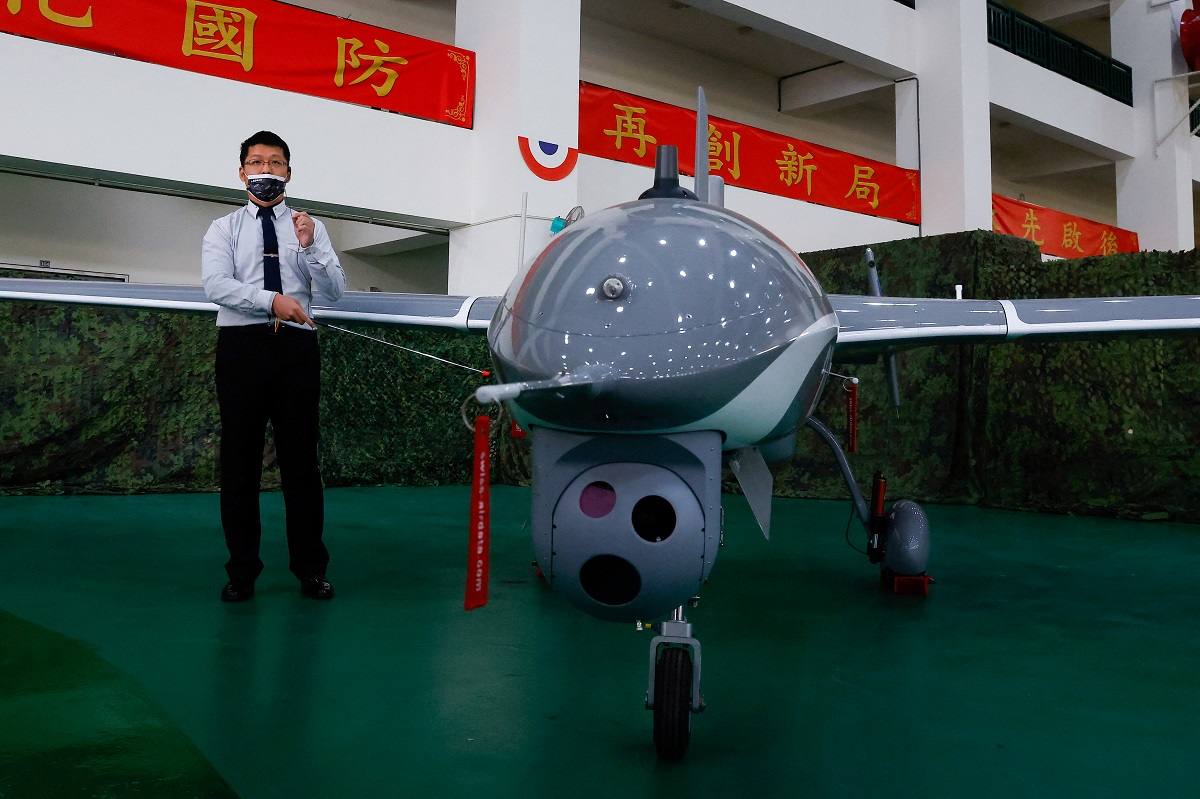
A view shows an Albatross II UAV on display as Taiwan’s Defence Ministry showcases its domestically developed drones to the media, in Taichung, Taiwan March 14, 2023.
11:39 JST, March 15, 2023
TAICHUNG, Taiwan (Reuters) – Taiwan showcased new models of its domestically produced military drones on Tuesday, saying they are key to its “asymmetric warfare” capacity to make its forces more agile if they have to face a far larger Chinese military.
China, which has never renounced the use of force to bring Taiwan under its control, has ramped up military activity near the democratically governed island to force it to accept Chinese sovereignty despite Taiwan’s objections.
The war in Ukraine has lent new urgency to Taiwan military’s efforts to bolster defense including a push to develop drones.
In a rare display of its drone capabilities, the military-owned National Chung-Shan Institute of Science and Technology (NCSIST), showed off its latest models, including the Albatross II surveillance drone, and combat drones that operate with global positioning system satellites.
NCSIST head Art Chang said the war in Ukraine had focused attention on drones, and his institution had teamed up with Taiwan companies to build a “national team” to develop military drones.
Taiwan’s military has announced a partnership with companies aimed at producing 3,000 drones next year.
Chi Li-Pin, director of Aeronautical Systems Research Division for NCSIST, said the armed forces should increase their adoption of drones in their strategies.
“I hope our national troops can familiarize themselves with this weapon of asymmetric warfare and use them boldly,” he told reporters at an NCSIST facility in the central city of Taichung.
President Tsai Ing-wen has championed the idea of “asymmetric warfare” to make Taiwan’s forces more mobile and harder to attack.
Taiwan’s armed forces are well-equipped but still dwarfed by China’s.
Among the drones on display was an attack drone with loitering munitions that can cruise towards a target before plummeting at velocity and detonating on impact.
China has sent its drones to areas close to Taiwan to test its responses, the island’s defense ministry has said.
Last year, Taiwan shot down a civilian drone that entered its airspace near an islet off the Chinese coast.
The island’s defense ministry said in a report to parliament this week, a copy of which was reviewed by Reuters, that China was quickly building up its combat capacity with drones, including swarms of flying robots.
In response, Taiwan will focus on developing its combat and surveillance drones, as well as anti-drone systems, the ministry said.
"News Services" POPULAR ARTICLE
-

American Playwright Jeremy O. Harris Arrested in Japan on Alleged Drug Smuggling
-

Japan’s Nikkei Stock Average as JGB Yields, Yen Rise on Rate-Hike Bets
-

Japan’s Nikkei Stock Average Licks Wounds after Selloff Sparked by BOJ Hike Bets (UPDATE 1)
-

Japanese Bond Yields Zoom, Stocks Slide as Rate Hike Looms
-

Japan’s Nikkei Stock Average Buoyed by Stable Yen; SoftBank’s Slide Caps Gains (UPDATE 1)
JN ACCESS RANKING
-

Keidanren Chairman Yoshinobu Tsutsui Visits Kashiwazaki-Kariwa Nuclear Power Plant; Inspects New Emergency Safety System
-

Imports of Rare Earths from China Facing Delays, May Be Caused by Deterioration of Japan-China Relations
-

University of Tokyo Professor Discusses Japanese Economic Security in Interview Ahead of Forum
-

Japan Pulls out of Vietnam Nuclear Project, Complicating Hanoi’s Power Plans
-

Govt Aims to Expand NISA Program Lineup, Abolish Age Restriction

























